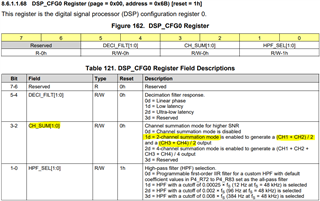Other Parts Discussed in Thread: TLV320ADC5140, PCM5102, PCM5102A
Our I2S Master is the TLV320ADC5140. Here is our TLV startup sequence for this example, 96khz. We can successfully capture audio, however when trying to play back via the PCM5122 on the same PCB, there is no audio output on OUTL or OUTR.
Our I2S lines look like this: BCK 24.576mhz, SCK (from XO): 24.576mhz, LRCK/FSYNC: 96khz. DIN on the PCM5122 shows the playback signal. Again, no analog audio output with i2c sequence below.
ADR1 is HI, ADR2 is LO, giving us i2c base address of 0x4D. It seems we can successfully communicate with both the TLV320ADC5xxx (I2C 0x4C) and PCM5122 (0x4D) on the same i2c bus.
Here is the last I2C sequence we tried (this is being run *after* starting up the TLV ADC I2S Master). We're trying the simplest method; just the bare minimum to make the DAC work.
w 77 reg 0x2 val 0x10 b10000 w 77 reg 0x1 val 0x11 b10001 w 77 reg 0x2 val 0x0 b0 w 77 reg 0xd val 0x0 b0 w 77 reg 0xe val 0x0 b0 w 77 reg 0xe val 0x2 b10 w 77 reg 0x25 val 0x7d b1111101 w 77 reg 0x28 val 0x3 b11 w 77 reg 0x3d val 0x30 b110000 w 77 reg 0x3e val 0x30 b110000 w 77 reg 0x41 val 0x0 b0 w 77 reg 0x2 val 0x0 b0
Are we missing something? For reference, here is the ADC's I2C startup sequence:
w 76 reg 0x2 val 0x91 b10010001 w 76 reg 0x13 val 0x87 b10000111 w 76 reg 0x14 val 0x58 b1011000 w 76 reg 0x21 val 0xa0 b10100000 w 76 reg 0x7 val 0x87 b10000111 w 76 reg 0xb val 0x20 b100000 w 76 reg 0xc val 0x20 b100000 w 76 reg 0xd val 0x0 b0 w 76 reg 0xe val 0x0 b0 w 76 reg 0x3d val 0x0 b0 w 76 reg 0x42 val 0x0 b0 w 76 reg 0x47 val 0x0 b0 w 76 reg 0x4c val 0x0 b0 w 76 reg 0x6b val 0x4 b100 w 76 reg 0x3c val 0xb8 b10111000 w 76 reg 0x41 val 0xb8 b10111000 w 76 reg 0x46 val 0xb8 b10111000 w 76 reg 0x4b val 0xb8 b10111000 w 76 reg 0x76 val 0xf0 b11110000 w 76 reg 0x73 val 0xf0 b11110000 w 76 reg 0x74 val 0xf0 b11110000 w 76 reg 0x75 val 0x60 b1100000




